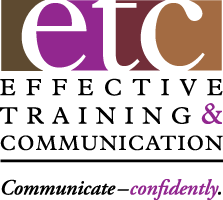Seems hard to believe, but something as small and potentially insignificant as your speaker notes can make the difference between good presenters and great ones in the eyes of your audience. And, after all, their perception is your reality.
What follows is a collection of speaker notes Worst and Best Practices based on a combination of on-going professional research, personal practice, observing best-in-class presenters and coaching many workplace presenters. See how your use of notes compares to them.
#1. Don’t memorize it. No audience in a typical workplace presentation, sales pitch or training seminar expects presenters to memorize their material. That takes way too much time, presents too many challenges to typical people and usually looks canned and fake. Your audience only knows what they hear, not what you should or could have said. So, the answer is to LEARN your presentation, not memorize it.
#2. Don’t use your outline. While a complete full-sentence content outlines is an essential tool for creating and organizing your content, you wrote it for your eye, not your audience’s ears. And, it’s way too detailed. Presenters who use outlines as speaker notes wind up reading from them too much with all the negative results that produces. Instead, create a succinct key word/phrase speaker note document. And print it in a large enough font size so you can easily see it – not the 11-point font you used for your outline.
#3. Don’t read your notes. Few practices annoy audiences more that presenters reading to them, whether it’s from their notes … or worse, their slides. It greatly reduces your eye contact and limits effective gesturing because you’re hold on to your notes. It’s logical and natural to refer to notes when you need to remember what to say next. Just remember to always do so in silence.
#4. Don’t use 3 x 5 note cards. They’re way too small to be of much value. Good idea for recipes maybe, but not for presenter notes. And, if you do use large type that’s easy to read quickly, you’ll need a lot of them and will spend way too much time changing them … or picking them up when you drop them. Your best bet is to use 8.5 x 5.5 (half page) card stock for your notes. They’re larger, hold more and are easier to handle. That’s probably why most of the TV talk show hosts use them.
#5. Don’t use your slides. Properly designed slides shouldn’t have a lot of text to begin with so they won’t be of much help as notes. If you must use them, look at them in silence to refresh your memory, turn back to the audience, find a face and begin talking again. The annoying tendency is for presenters to read their slides to the audience with their backside facing them. Not a good idea at all for projecting confidence and engaging the audience.
So, make your delivery noteworthy by using the right kind of speaker notes in the right way and not letting them get between you and your audience. The best workplace presenters you’ve seen either practice their message enough that they don’t need notes or use notes so subtly and naturally that you may not even notice. You can too!
